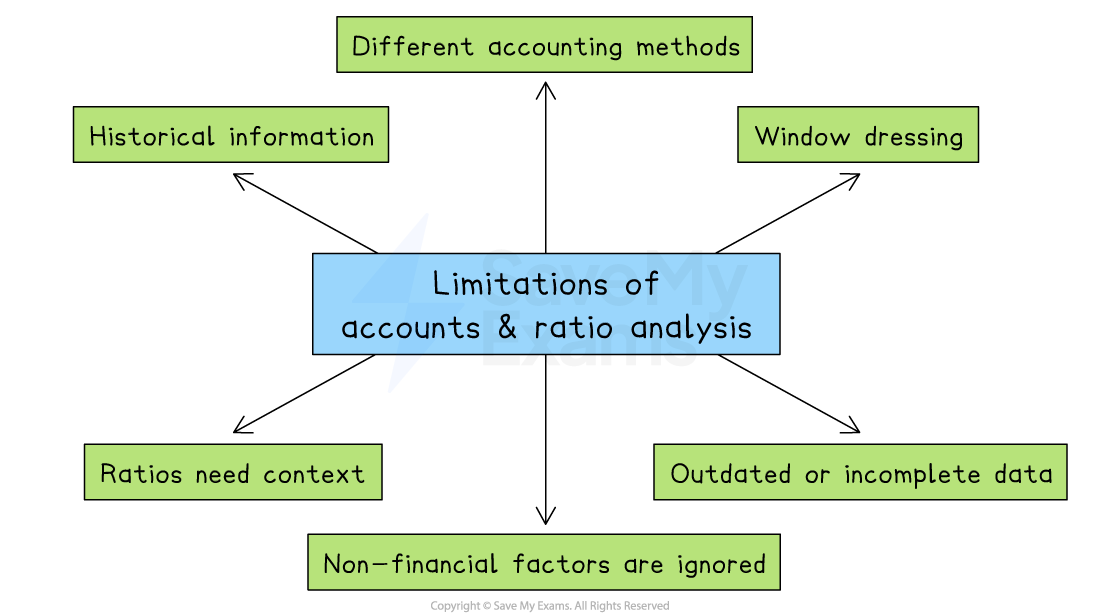Using Ratio Analysis To Make Strategic Decisions (Cambridge (CIE) A Level Business): Revision Note
Exam code: 9609
Assessing business performance over time
Ratio analysis involves comparing financial figures from the accounts to create meaningful measurements of profitability, liquidity and efficiency
When ratios are tracked over several time periods, they help identify trends in a business’s performance
Ratio analysis:
Identifies improvements or problems
By comparing ratios year-on-year, businesses can see if performance is getting better or worse
For example, a rising profit margin suggests improved profitability, while a falling current ratio may signal cash flow issues
Supports decision-making
Trends revealed through ratio analysis help managers decide whether to expand, cut costs, raise finance or change strategy
Highlights consistency or instability
Stable ratios suggest a reliable and well-managed business, while sudden changes may point to risks or changing conditions
Case Study

Loma Catering Ltd is a mid-sized catering company. based in Gaborone, Botswana, specialising in corporate and event catering
Over the past two years, the business has seen its gross profit margin rise from 40% to 45%. This improvement came from two key changes
Raising prices slightly on premium event packages
Reducing food waste through better portion planning and supplier negotiations
However, during the same period, Loma’s gearing ratio increased sharply, rising from 28% to 60%. This happened after the company took out a large loan to invest in a fleet of delivery vehicles and build a new commercial kitchen
While the improved gross profit margin shows that the business is becoming more efficient and profitable, the rise in gearing means it is now heavily reliant on borrowed finance, increasing its financial risk
Outcome
Loma's management is now focusing on generating enough retained profit to fund future expansion without increasing debt
Comparing business performance with competitors
Ratio analysis can also be used to compare a business’s performance with that of other firms in the same industry
Benchmarks performance
Comparing ratios helps businesses judge whether they are performing above or below the industry average
Reveals strengths and weaknesses
A higher return on capital employed (ROCE) than a rival suggests better use of investment
A lower current ratio may show weaker short-term financial health
Supports strategic planning
If a competitor has stronger profitability or better cost control, the business can investigate and improve its own operations to stay competitive
Ratios and debt and equity decisions
When a business chooses how to finance its operations, it directly affects several key ratios used in analysing performance
These choices can change how the business appears in terms of risk, profitability, and financial strength
The impact of debt and equity decisions on ratios
1. Gearing ratio
Taking on more debt increases the gearing ratio
This indicates greater financial risk and a higher dependency on borrowed funds
Using equity reduces gearing
This indicates a more stable capital structure with lower financial risk
2. Return on capital employed (ROCE)
Raising equity increases capital employed
This can reduce ROCE unless profits rise too
Using debt may lead to a higher ROCE if the borrowed funds increase profits
However, this approach carries greater financial risk
3. Dividend cover
More debt means higher interest payments, which reduce net profit
This may lower the dividend cover, making dividend payments less sustainable
Raising finance through equity avoids interest costs and may result in a higher dividend cover
This suggests more secure payouts, though profits must be shared among more shareholders
Ratios and dividend strategy
Dividend strategy is how a business decides:
How much profit to return to shareholders as dividends
How much profit to keep (retain) in the business for future investment
How does the dividend strategy affect key ratios?
1. Return on capital employed (ROCE)
If more profits are retained (fewer dividends paid), capital employed increases
This could lower ROCE, unless operating profit increases due to reinvestment
E.g. When KohliTech Plc, an Indian technology firm, reduced dividends to invest in innovation, ROCE fell in the short term but rose later when profits increased
2. Current ratio and acid test ratios
Paying high dividends reduces cash, a key current asset
This may reduce liquidity, making it harder to pay short-term debts
E.g. South African supermarket chain Choppies paid large dividends to its shareholders before the pandemic and, as a result, struggled with cash flow when sales dropped in the early part of 2021
3. Price/earnings ratio
A change in dividend strategy doesn't directly affect the price/earnings ratio
However, lower dividends may worry investors, reducing share price, which lowers the ratio
If reinvestment leads to higher profits, share price may rise, increasing the ratio over time
Business growth and ratio results
When a business grows, whether by increasing sales, opening new branches, acquiring other firms or expanding into new markets, it can have an impact on a range of financial ratios
The impact of business growth on selected ratios
Ratio | Explanation |
|---|---|
Return on capital employed |
|
Current ratio |
|
Inventory turnover |
|
Price/earnings ratio |
|
Other business strategies and ratio results
1. Cost-cutting strategy
A business might reduce its costs by lowering wages, using cheaper materials, or cutting back on overheads like advertising or travel
Ratio | Explanation |
|---|---|
Profit margin |
|
Inventory turnover |
|
2. Paying higher dividends
A business may decide to return more profits to shareholders by increasing dividends
Ratio | Explanation |
|---|---|
Current ratio |
|
Price/earnings ratio |
|
Limitations of using published accounts and ratio analysis in decision-making
Published accounts (like the income statement and statement of financial position) and ratio analysis are useful tools
However, they should never be the only tools used when making strategic decisions
A business should always consider the full picture, including market trends, people, and future risks

Key limitations of using accounts and ratio analysis to make decisions
Historical information
Accounts are based on past performance, not the future
Ratios reflect what has happened — not what will happen next
Non-financial factors are ignored
Ratios and accounts don’t include qualitative factors such as
Staff morale
Customer loyalty
Brand reputation
Innovation and leadership
These factors can have a significant impact on business success, so ignoring them means only a partial picture of a business is gained
Different accounting methods
Businesses can choose different methods for things like depreciation or valuing inventory
This makes it difficult to compare companies directly
Window dressing
Some businesses try to make their accounts look better than they really are
For example, delaying bill payments or boosting end-of-year sales temporarily
Outdated or incomplete data
Published accounts may be up to 12 months old by the time decisions are made
The impact of important recent events, such as losing a major contract or the impact of an external economic downturn, might not yet be evident
Ratios need context
A ratio on its own is not very useful
In order for financial performance data to be meaningful, a business must compare it to
Past performance (trends)
Industry averages
Similar businesses

Unlock more, it's free!
Did this page help you?